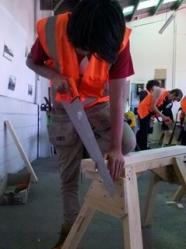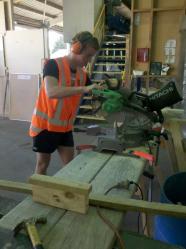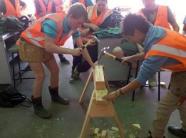Learning pathways
Teaching inquiry
How can we provide off-site learning opportunities for our students in a way that complements rather than conflicts with their school-based learning?
Introduction
Amuri Area School has found ways to expand opportunities for students by partnering with Canterbury Trade College (CTC) and radically re-organising their timetabling for the senior school. These strategies have provided many benefits, including:
- improved transitions into apprenticeships and tertiary learning
- increased student engagement and achievement
- reduced absenteeism
- enrolment of adults at the school.
Background
Amuri Area School in Culverden, North Canterbury, has a roll of 268 students including 51 in years 11–13.
Principal Neil Wilkinson and deputy principal Penny Mossman were searching for ways to improve their students’ transition into further education and work. They were concerned that the range of programmes on offer was not broad enough to engage all their year 11 students and keep them in education.
Strategy
Providing rural programmes and trades programmes for senior students
As part of a 12-month trial, seven students from Amuri travelled into Christchurch (100km) every Thursday to participate in rural programmes run by the National Trade Academy and trades programmes run by Canterbury Tertiary College. Transport was provided by parents, a community member keen to help out, or occasionally Neil or Penny themselves. Since the earthquakes, the journey can take up to one and three-quarter hours.
Students (all boys) enrolled in the two-day Canterbury Tertiary College programme organised their own overnight accommodation and made their own way to the CTC in the morning.
Providing off-site training
As the 12-month trial progressed, Emma Meijer of CTC could see that there would be advantages in taking CTC to the students instead of having the students come to CTC. Local principals and Emma agreed that Amberley would be a suitable location, and the Hurunui District council offered them a vacant building for the programme.
The two-day trades course became one day a week in Amberley plus four one-week blocks in Christchurch. Each Friday, the tutors bring the tools and equipment they need from Christchurch. The students put their developing skills to work as they contribute to useful projects such as the construction of playhouses and playground equipment.
It’s a win–win situation as the Hurunui council is seen to be supporting their youth, and the community is seeing something happening as a result of the trade programmes.
Penny Mossman
Read more about the off-site training CTC provides in this article on the Christchurch Polytech Institute of Technology website.

CTC tutors have set up a Facebook page to communicate with students and celebrate successes.
It is not practicable to bring heavy trades machinery all the way to Amberley each Friday, so learning to use this equipment is reserved for the week-long programmes in Christchurch.
Parents are expected to help out by taking their turn at driving. They are rostered to drive the school van to and from Amberley. This requirement is spelt out in course outlines.
For the block weeks, we take them down on the Monday, they provide their own accommodation for the week, and then we pick them up on the Friday. It’s been good practice for the boys in managing self, as they need to make their own way from their accommodation to class at CTC each day.
Penny Mossman
Year 11 students participate in a multi-trades programme that includes aspects of plumbing, electrics, and welding. After the first (taster) year, they can specialise in a chosen trade such as electrical, mechanical engineering, painting, or plastering.
The students are dual enrolled. We do lose funding when they go to CTC. However, what matters most is what is best for the student. Claims to the Ministry of Education are made by CTC to help students with accommodation and costs. There is definitely a cost in time (as well as funding) for organising this system. But we are putting the student at the centre of our decision-making. This could be what twenty-first century learning looks like!
Penny Mossman
Restructuring the senior school timetable
To better meet the needs of this group of students and others involved in off-site learning, Amuri Area School has completely restructured its senior school timetable. On Tuesdays, Thursdays, and Fridays, periods 2–5 are allocated to one subject. On Mondays and Wednesdays, the teaching day is divided into two blocks of two periods, plus a single period.
The new structure neatly accommodates students at CTC or on work placement. It also makes it much easier to arrange field trips and other learning opportunities.
Student timetables (Word 2007, 334 KB)
A side affect of the restructure is that junior students have more double periods but neither students nor teachers find this a disadvantage.
Outcomes
A lot more of our students are staying longer because these programmes suit them. Last year, as a result of the trades academy, one student went into an apprenticeship and the other two into mechanical engineering. The four students who attended a land-based academy are now in a level 2 rural studies class here at school.
All students enrolled in trades academies last year achieved level 1, and one achieved level 2. Those who are in their second year are on track to achieve level 2 – in fact, most already have.
Students rarely if ever miss their CTC course. Once they are in, they are hooked. After their block week, we thought that school might be a bit of a bore, but they came back seeing greater value and relevance in the other learning packed around this course.
Penny Mossman
In 2012, 88% of all year 11 students achieved NCEA level 1, and within that 100% of trades academy students achieved level 1.
Penny sees the boundaries between secondary and tertiary education becoming increasingly blurred.
It’s a great step forward for a seamless transition to apprenticeships and/or tertiary learning. It has opened our students’ eyes to the range of employment opportunities in the trades sector. We are mainly a dairying and farming community and our students are not necessarily exposed to, or very aware of, the opportunities in these other career pathways.
Penny Mossman

The school sees these changes as affirming the worth of all vocational pathways and recognising that all students have a valuable contribution to make in the workforce and to their communities.
The changed timetable has had a positive effect on absenteeism because students realise that if they miss a day, they miss a whole week of learning in one subject.
The parents have been positive right from the beginning. They are quick to see advantages in a timetable that opens up opportunities for local young people. They have been excited to see their sons coming home “buzzing” about what they have done and learned.
The blocked timetable is now in its second year. An external review of its impacts was carried out at the end of last year.
External review of timetable: Amuri Area School (PDF, 883 KB)
It has its challenges. However, the staff and students have embraced the change and adapted to a very different teaching environment. No one is keen to go back as there are more upsides to this change than downsides. There is less packing up and unpacking, teachers can take more of a facilitation role, and they enjoy taking breaks when it suits the day’s work. The relationships in the classroom seem different. The sciences, arts, PE and technologies really love it. The other subjects are gradually adapting to it.
Penny Mossman
Despite the cost of dual enrolment, the school has not had to reduce staffing because more students are staying longer.
Ten adults have also enrolled at the school. The blocked timetable suits them because they can get one day a week off work and in that day cover the requirements for the subject that interests them. This enrolment of adults has been an unexpected bonus for the school and community.
What next?
Feedback from the community about the Amberley centre has been very positive, and the council is now hoping to make a better building available for next year.
At every year level, we would like to have something that students can access. The trades academy has only had boys enrolled. However, if a girl were interested, we would support this. CTC works with other polytechnics, including Christchurch Polytechnic Institute of Technology (CPIT) and Southland Institute of Technology (SIT), and has access to a broad range of courses. We will base the programmes on what each cohort wants to do – this can differ from year to year. Soon we will need to work out what our level 1s want to specialise in next year. We will continue to work with other schools.
CTC offers a wide range of programmes but we can’t access everything as we are constrained by the timetabling there. However, they have been very accommodating and are always willing to find a way forward if we can find the numbers. This success is all about about effective working partnerships – the students, the parents, the school, the community, and CTC.
Penny Mossman
CTC and other tertiary providers, together with secondary schools, are beginning to have broader conversations with Ministry of Education Youth Guarantee personnel about curriculum and programmes for 16–18 year olds. These conversations revolve around the question:
What does a coherent, integrated programme that addresses key competencies, core curriculum (English, mathematics, science), discipline knowledge, and industry-related knowledge look like?
Penny Mossman

